Croatia Animal Friends Urge Croats to Switch to Meatless Diet on Meatout Day
ZAGREB, 19 March 2022 - On the occasion of Meatout Day, observed on 20 March, Croatia Animal Friends urge Croatians not to buy a lot of unnecessary food stocks and to switch to the cereals-based diets.
Switching to the meatless diets in the circumstances of the Russian invasion of Ukraine can also help prevent a possible crisis in food availability, this NGO said in a press release issued on Saturday.
Russia's military aggression against Ukraine has triggered off fears that there will be food shortages, supply chains' disruptions and consequently basic cereals' price rises, the NGO says calling on the general public to think about healthy vegetarian nutrition so as to put an end on the slaughter of animals.
The association says that the benefits can be proved mathematically.
For instance, the production of one kilo-calorie of beef or lamb requires 100 times more land than what is necessary for the production of cereals.
In order to produce a kilo of meat, 15,000 litres of water is necessary, whereas 100 litres of water is required for a kilo of cereals, it added.
The NGO warns that the excessive purchase of food is a senseless way to address the issue of food shortages that could be caused by the war in Ukraine, known as the "breadbasket of Europe", We should be more aware of the repercussions of meat-producing industry and cease eating meat, says the Croatia Animal Friends.
MeatOut was started in 1985 by Farm Animal Rights Movement (FARM) in the USA to promote a conversation questioning the consumption of animal products around the world. March, 20 was selected as symbolic of renewal and turning over a new leaf at the start of spring.
Festivities in Eastern Slavonia: Things To Do in Spring
18 March 2022 - Spring is on the horizon! Ceremonies and events are slowly but surely moving outdoors and since TCN already covered “Five Places You Must Visit During Spring in Croatia”, this is a look into what festivities in Eastern Slavonia are happening during the new season.
Firstly, we need to start with the biggest city of Eastern Slavonia - Osijek. As usual, the greenest city in Croatia has various events that can fulfill any person's preferences: from music, film, theater, and traditional events to sports and other activities that include all of citizens and guests. Since there is no shortage of events this spring season, we had to single out a few that will happen soon. It doesn't hurt to mention again that Osijek is going to host the 29th Porin Music Awards on the 25th of March. For more details, check the article here.
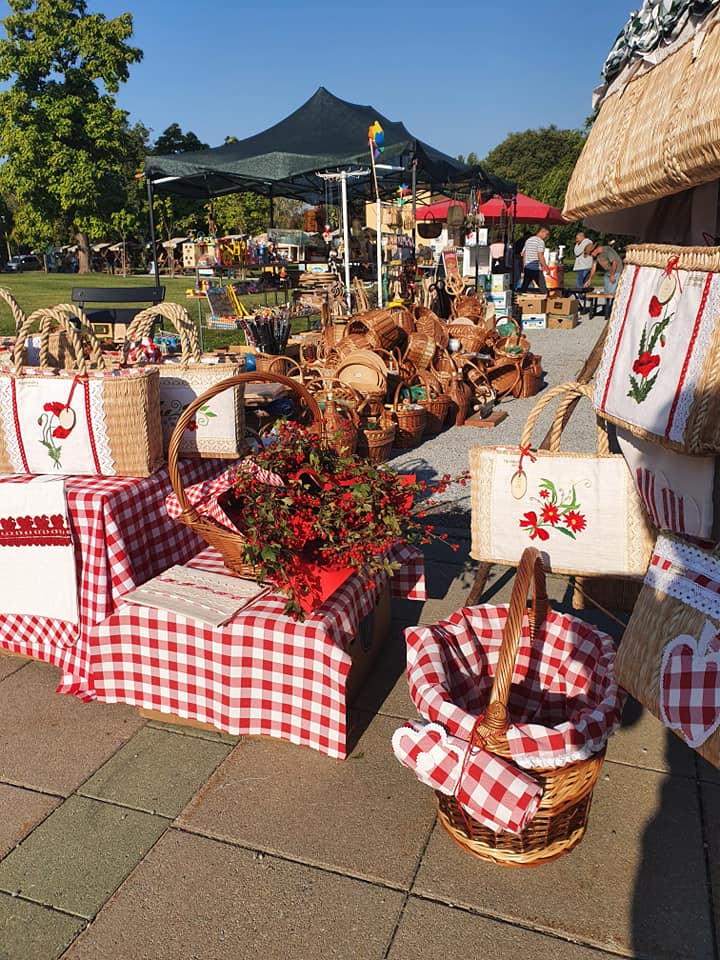
Antiques Fair, (Photo:Okusi sreće by Pavica/Facebook)
Antiques Fair - 2nd of April
The citizens of Osijek love their culture and heritage so it’s not surprising that the Antiques Fair is one the most popular events in the city. From old gramophone records to lost books and masterpieces from local unknown artists, this festivity is for everyone. Excitement as you pass by a sea of stalls that potentially contain a lost “treasure”? It is guaranteed only at the Osijek Antique Fair that is usually held on the first Saturday every month in the Old Town of the city - Tvrđa. However, the next Antique Fair will be held in King Držislav Park near the famous urban statue The Shell (Školjka) on the 2nd of April. The Park is located just across from Tvrđa, so it is not hard to find it. You can check for more here.
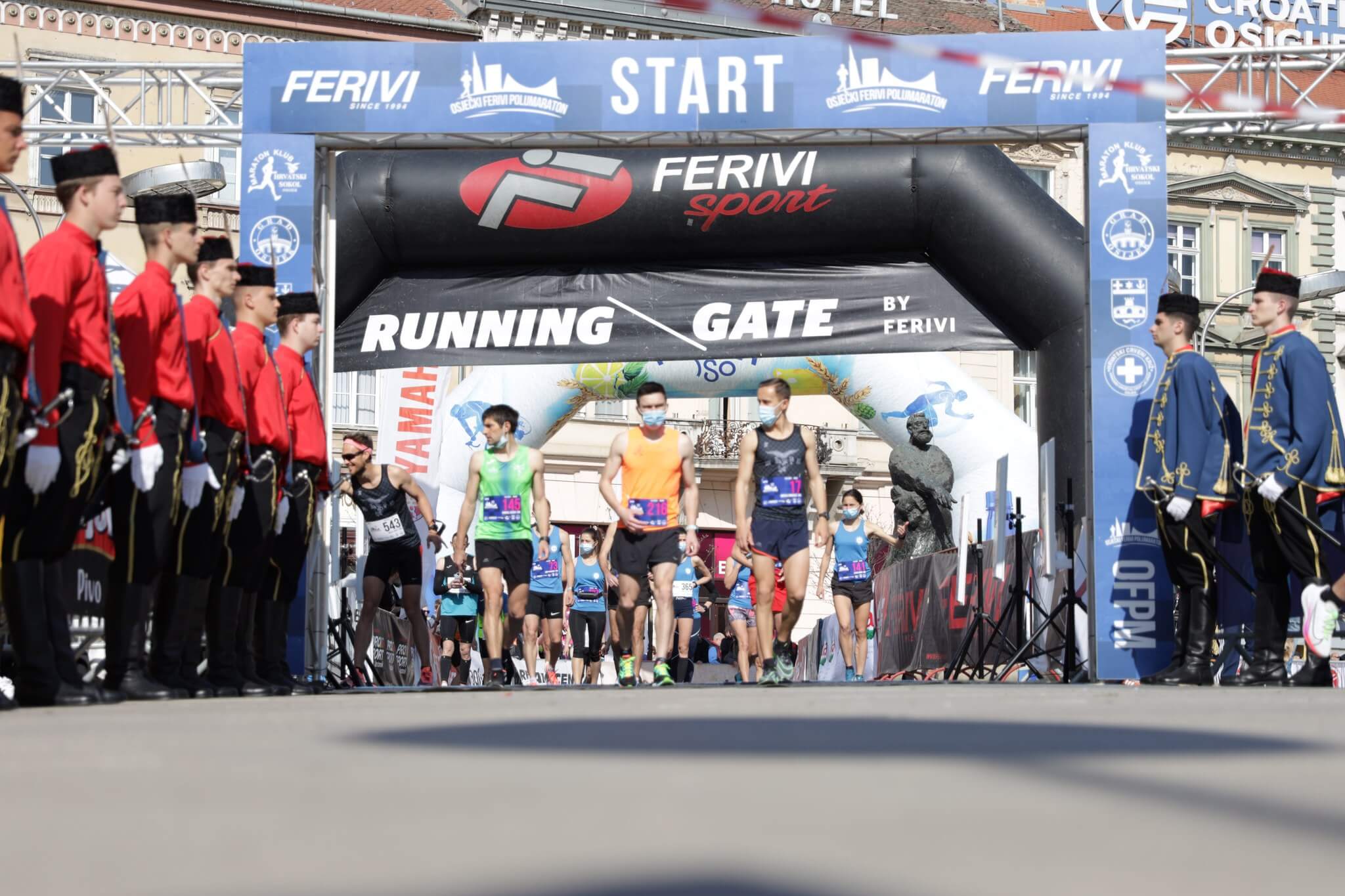
Osijek Ferivi Half Marathon (Photo Osječki Ferivi Polumaraton/Facebook)
18th Osijek Ferivi Half marathon - 9th of April 2022
This event, as the name suggests, will take place in Osijek, with four different races included: a half marathon (21.1 km), relay (3 x 7 km), citizens’ race (5 km), and a race for the youngest - children. These events will be accompanied by a music festival, instrumental, dance, and singing groups with a goal to entertain the visitors and competitors. Since its foundation, Osijek Ferivi Half Marathon has had an increase in the number of participants every single year and it’s becoming one of the biggest sporting events in Osijek and its surroundings. If you’re interested, the application is still open for everyone - it doesn’t matter if you’re a professional or casual, everyone is welcome!
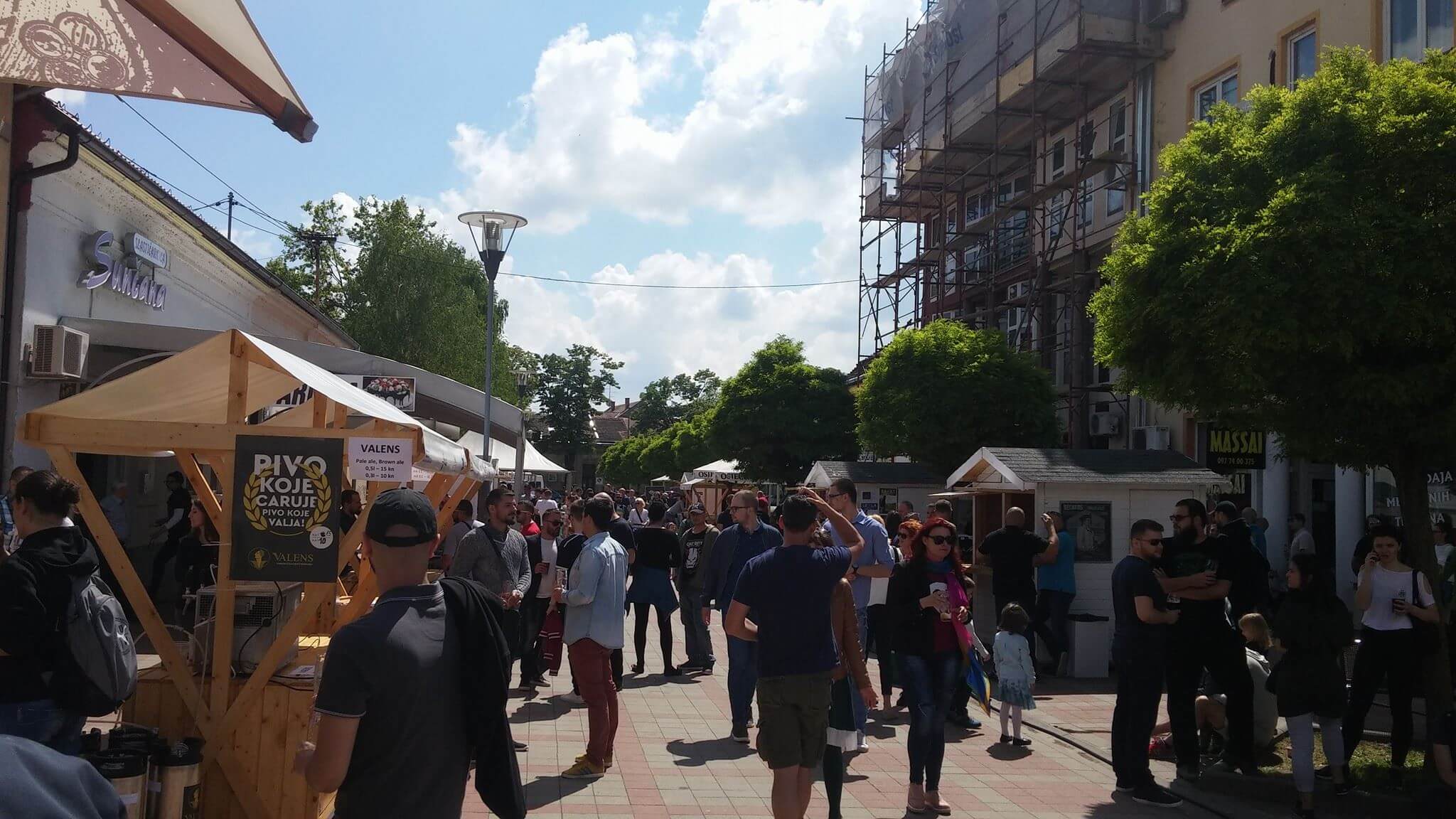
Craft Beer Festival in Osijek (Photo: Osijek CRAFT BEER Festival/Facebook)
Craft Beer Festival - sometime in May (to be determined)
How can Spring pass in Osijek without an event for beer lovers? In the last decades, Osijek has become a center for beer connoisseurs, not only in Eastern Slavonia but for beer enthusiasts all over Croatia. This fact is not surprising at all if we take into account that Osijek is also a center of multiple small breweries that produce various types of beers which have become iconic for this part of Croatia. Craft Beer Festival has been held last year during June but this year it’s probably coming back to its original date in May. We still don’t know the exact date. Nevertheless, the event will come back to the famous so-called “beer street” - Sun Street (Sunčana Ulica). For updates check their Facebook page.
If you’re interested in breweries in Osijek, check an article from our intern Toni.
After Osijek, we go further East and present cities of Vinkovci and Vukovar. Two historical Slavonian cities have a lot to offer with the support of surrounding small towns and their own events that enrich the lives of locals in Vukovar - Srijem County.
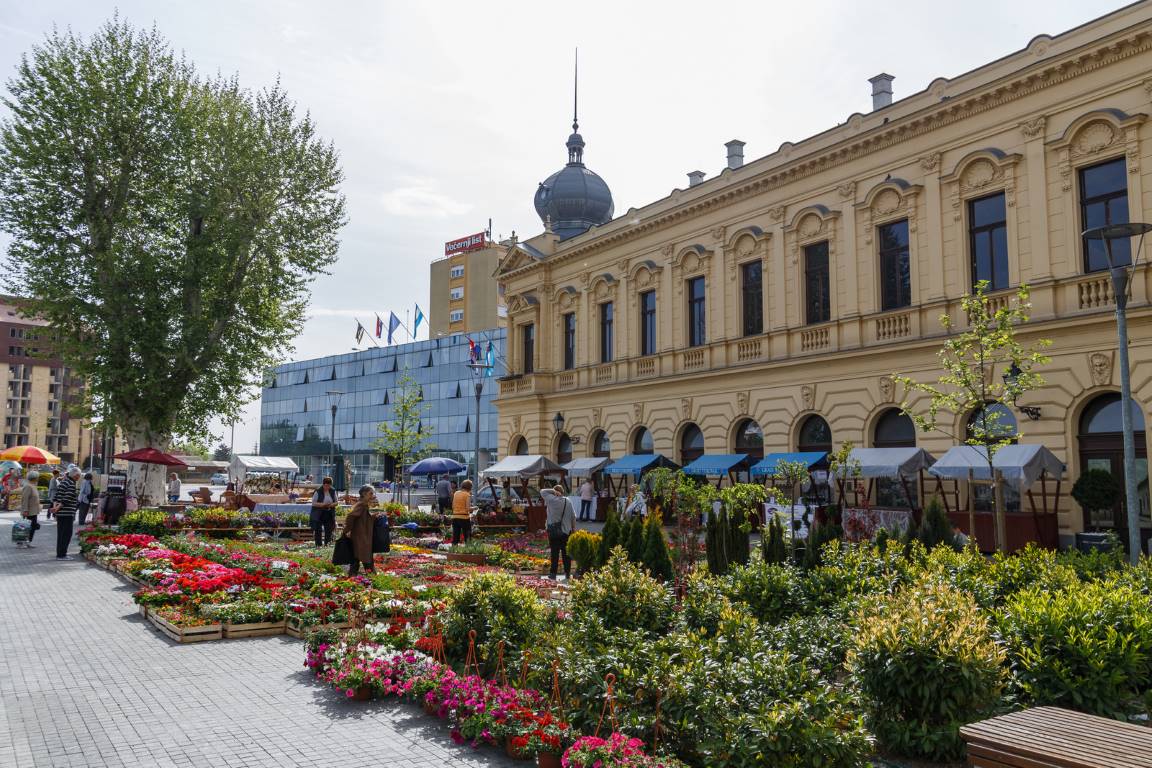
Flower Festival in Vukovar (Photo: Miroslav Slafhauzer/Turistička zajednica grada Vukovara)
Flower Festival - end of the April
Flower Festivals are a common event in Slavonia (we already had one in Osijek during Women’s Day). At the end of April every year, a Flower Festival is held in the center of Vukovar which brings together local and regional plant growers, florists, arrangers, related craftsmen, and lovers of flowers and ornamental plants. The Fair has sort of an exhibition and sales character which gives a completely different, colorful, and warmer look to the center of Vukovar. This event is also an overture for marking City Day.
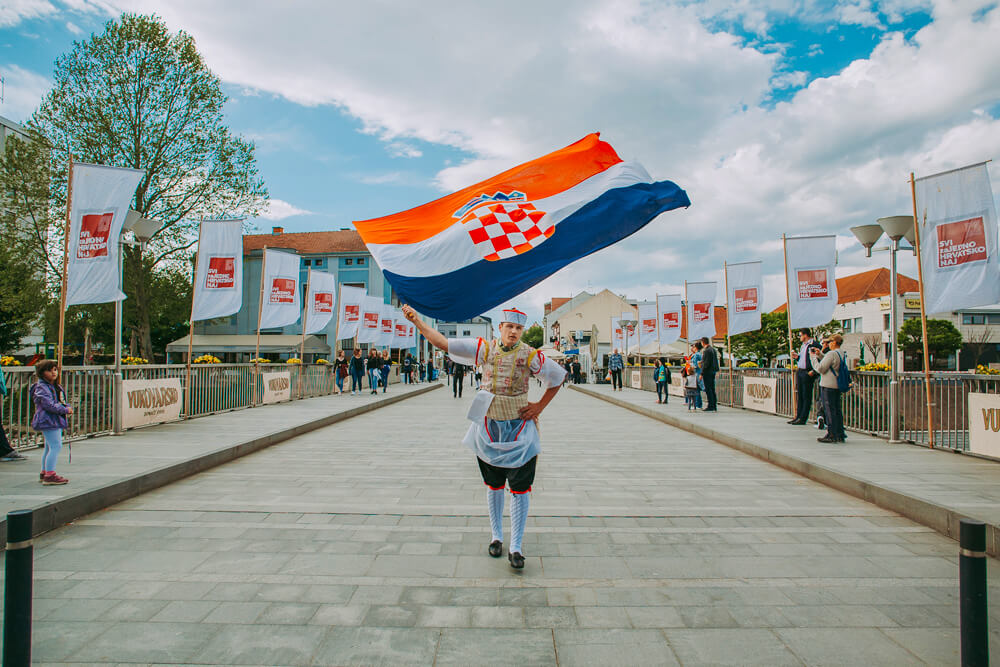
Svi zaJedno Hrvatsko Naj Festival in 2019 (Photo: svizajedno.eu/Galerija)
Svi zaJedno hrvatsko naj - cultural and tourist event - part of Vukovar City Day, 3rd of May
This festival is fairly new - it was firstly held in 2018, as a part of the European Year of Cultural Heritage. Its uniqueness lies in the fact that it is the first Croatian festival to present protected Croatian intangible cultural heritage on the national and UNESCO list with the most attractive tourist events, attractions, and destinations from all over Croatia. During the event, visitors have a chance of exploring various manifestations held all over Croatia by tasting autochthonous Croatian dishes and enjoying the offer of the best Croatian wines. Of course, what would be a Slavonian event without traditional music and dance groups? For more details, you can check their website.

"Motorijada" in 2021 (Moto Klub Županja/Facebook)
Motorijada by Moto Club Županja - 10th of April
Motorijada (Moto Race) is an event that is organized by Moto Clubs all over Croatia. Motorcycle enthusiasts organize these events to promote, among other things, motorsports and use this opportunity to meet with their fellow motorcycle buddies. This April, Moto Club Županja is organizing the 16th Opening of Moto Season of Vukovar - Srijem County with the aim of drawing the attention of other road users to the presence and safety of motorcyclists in the traffic. They will start their tour in the village Rajevo Selo and go through multiple towns in Vukovar - Srijem County with the ending in the host city - Županja. Everyone is invited and if you’re a motorcycle enthusiast or just love looking at the motors, this is a great event to visit. For more information, check their Facebook page.
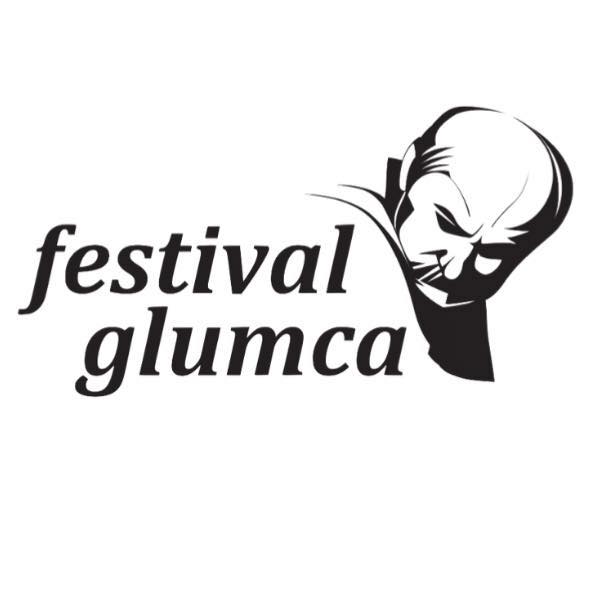
Logo of the Festival (photo: Festival Glumca/Facebook)
Actor’s Festival - all cities of Vukovar - Srijem County, 13 - 22 May
The festival was founded in 1994 by the Croatian Society of Dramatic Artists and Vukovar - Srijem County and it is the only festival in Croatia dedicated to the actor and their artistic work. Today, this event has grown into a festival that brings chamber and large ensemble performances to the audience. If you’re interested in the festival full of character, good acting, acting personality, talent, and originality, visit Vukovar - Srijem County from 13th to 22nd May this year. Every city will have its appropriate events surrounding this festival. For more, check their official website.
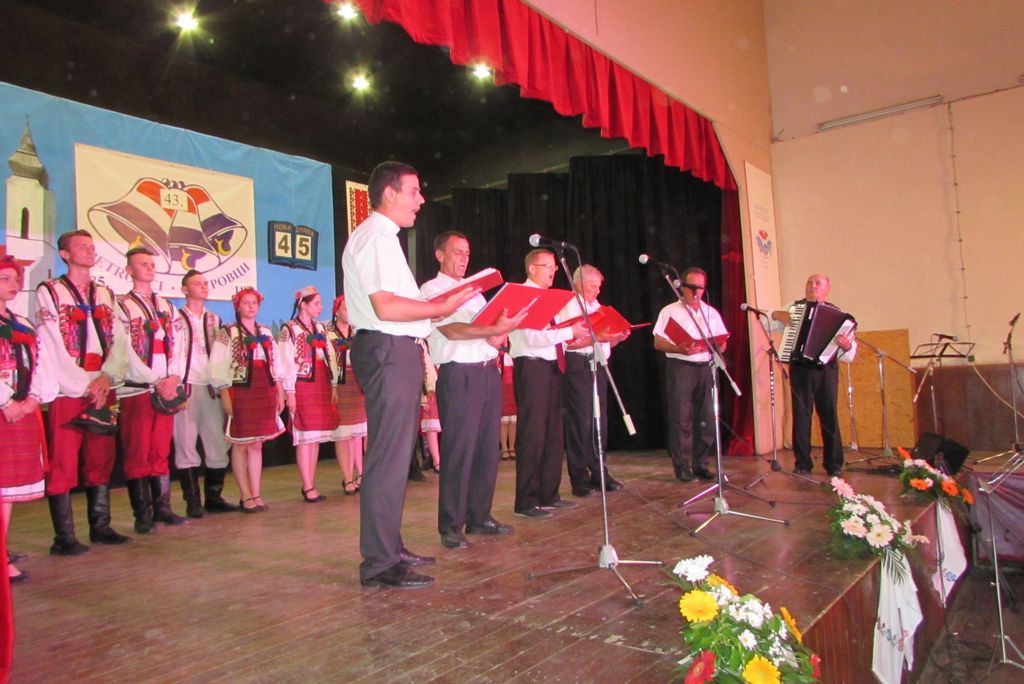
Petrovačko Zvono event few years ago (photo: savezrusina.hr)
Petrovačko Zvono - sometime in June, 49th edition
Rusyns are a national minority in Croatia with most of the residents residing in the village of Petrovci, which is located near Vukovar. Tradition, heritage, and constant maintenance of their culture for more than 40 years made this event one the most important in Vukovar - Srijem County. Rusyns from all over Croatia and other countries, visit Petrovci to connect to their fellow Rusyn people. They have a strong connection to Ukraine and their people, so if you’re nearby, visit this event, learn about the traditions of the people who’ve chosen Croatia as their home, and enjoy Petrovačko Zvono and its celebration of their heritage. For more details, you can visit their website here.
This is it for now. There are a lot more events that need mentioning, however, this article won’t be enough. TCN will bring you stories from some of these events and part two of places to visit in Eastern Slavonia is already on the way. Stay tuned!
Make sure to check out our dedicated travel section.
U.S. Secretary of State Thanks Croatian Government For Support to Ukraine
ZAGREB, 15 March 2022 - U.S. Secretary of State Antony Blinken has expressed his deep appreciation for the strong support of Croatian PM Andrej Plenković and his government for Ukraine, including providing security assistance and accepting refugees, and for Croatia’s active role in NATO, the U.S. Department of State said on Monday.
According to a statement signed by spokesperson Ned Price, Blinken reaffirmed U.S. support for Ukraine "in the face of President Putin's continued war against Ukraine.
"The Secretary expressed his deep appreciation for the strong support of Prime Minister Plenković and his government for Ukraine, including providing security assistance and accepting refugees, and for Croatia's active role in NATO."
Also discussed was the March 10 drone crash in Zagreb.
"The Secretary noted Croatia's critical role in securing the European future of the entire Western Balkans, including Bosnia and Herzegovina. The Secretary also welcomed the March 17 U.S.-Croatia Strategic Dialogue, which will bring together senior-level interagency teams to review joint efforts to advance shared priorities," the State Department said.
Women's Football in Croatia: Origins and Status Today
14 March 2022 - Women’s football in Croatia has gone through many changes throughout its history - from being solely a man’s sport to becoming one of the most popular for women worldwide. However, in Croatia, women's football still hasn’t received the traction it has in other countries, and many clubs, especially in Eastern Slavonia, saw an inevitable end. Why has this been happening, and what are the solutions to bring back the lost talents in women’s football? A look into women’s football in Croatia.
Women’s football has had many ups and downs throughout history. From being dismissed as only a man’s sport to its “golden age,” the ban that stopped the sport's progress and, in the end, one of the most significant rises in popularity of any sport in history. The “golden age” occurred in England at the beginning of the 20th century when British men were deployed and sent to the frontline during WWI. According to a BBC Three article from 2016, by 1921, there were around 150 women’s teams in England. A Boxing Day match in 1920 drew in crowds of nearly 70,000. However, after the war ended, women were pushed back to their “places” - closed in the houses to be housewives. In 1921, the “ban” was established, declaring it to be “quite unsuitable for females and ought to be encouraged!”. This “rule” was not lifted until 1971, and unfortunately, the damage has already been done.
If we compare Croatian women’s football history from that timeline, we could say it’s been a bit different. However, even though that sort of ban hasn’t occurred in the established Kingdom of Serbs, Croats, and Slovenes and later the so-called Kingdom of Yugoslavia, reservations about women in football were emphasized a lot. According to Grgic and his article “A Brief History of Women’s Football in Croatia/Yugoslavia in Between War Period,” football was generally open to both sexes. However, “experts” pointed out that women as sentient beings do not need to seriously follow men in sports because those who do it turn into masculine people. Throughout the article, Grgic also mentions multiple instances where football was solely considered for men, and women can only use it as a prop to “get into shape and take it easy because women are fragile.” This puts a lot of factors in perspective if we consider that communist countries (especially after WWII) like Yugoslavia set a significant emphasis on women's rights and their “rightful” part of the “revolution.” Still, even that couldn’t stop discrimination against women. But, once again, that didn’t stop women from playing football. For instance, ŽNK Dinamo-Maksimir is a Croatian women's football club based in Zagreb, and the club was founded as ŽNK Maksimir in 1937. The Yugoslav First Women's League was active between 1974 to 1991 and the fall of Yugoslavia. Zagreb, later called Maksimir, was the only Croatian club in the League, and the club with the most titles was Mašinac from Niš.
After the Homeland War, many Croatian women’s football clubs were founded, which led to the eventual establishment of the Croatian Women's First Football League formed in 1992, following the dissolution of the Yugoslav First Women's League, which is currently underway and features eight clubs.
However, in recent decades, women’s club popularity has not helped the sport's popularity in Croatia, especially in regions like Eastern Croatia. Yes, ŽNK Osijek is the most successful Croatian club in the country, but it didn’t help the inevitable shut down of multiple women’s football clubs, especially in Vukovar - Srijem county.
For instance, out of ten active women’s football clubs in the last two decades, only five of them stayed active with ŽNK Mikanovci, NK Dilj Vinkovci, and Graničar Županja mainly operating in Croatian Women’s Second League. The rest of them work only in younger categories. Displacement of the population, lack of children, and girls' disinterest in the sport made clubs shut down. Girls who wanted to play football had to go to other towns and clubs that were still active, and the best would go to ŽNK Osijek.
Also, most Croatian women’s football clubs pay miserable salaries to their players who are just too low for today’s living standards, whereas in lower league clubs' wages are just non-existent. However, in recent years there has been progress, namely in the infrastructure of the Leagues and clubs, possibilities of the clubs to pay to their players, and constant promotion of women’s football games. It made everything so much easier because of social media and an overall rise in the sport's popularity internationally.

Out of ten clubs, five of them shut down in recent years, and the rest of them are mainly operating in younger categories - Screenshot: Wikipedia
*ugašen (shutdown) *djeluje u mlađim kategorijama (operating only in younger categories)
After the ban was lifted in the UK, women’s football finally progressed. Leagues and football clubs were founded, and the first World Cup in 1991 in China was finally held. In recent times, FIFA World Cup in 2015 and 2019 reached new heights in popularity and brought unprecedented ratings, which could be compared to Olympic Games. Women’s football is now a rapidly growing sport that finally started getting an influx of money and popularity long ago.
Croatian FA recently joined the UEFA Playmakers program, which was created with Disney. The project's primary goal is to introduce football to girls aged 5 to 8 who never experienced playing sports. The program will take place in 2022 and 2023, and four editions will be organized. The first edition - in March 2022 - will follow the animated film Frozen 2. The training will take place on the fields and/or in the halls of women's football clubs so that girls can join the clubs and continue playing football after participating in the UEFA Playmakers program. This project will also include cities all over Croatia and help promote the sport to girls across the country.
In conclusion, after everything researched, we can say that the rise of women’s football in Croatia is inevitable. Of course, it will take a long time since nothing can be done in one day, but positive times are here. Croatian Women’s Football Leagues are slowly but surely developing talent. The Croatian National Team is playing in playoffs for multiple big tournaments, and I don’t doubt that they will one day qualify. The interest in the game is rising again - even though many clubs shut down, girls are once again willing to play football, and rightfully so, because it’s our game too - a women’s game.
To read more about sport in Croatia, follow TCN’s dedicated page.
Textile Businesses Net HRK 81m in Profits in 2020
ZAGREB, 12 March 2022 - In 2020, textile businesses netted HRK 81 million in profits, up 42.4% on the year, according to the Financial Agency.
That year there were 334 textile businesses with 3,521 employees.
Their revenues totalled HRK 1.6 billion, down 4.2% on 2019, while expenditures were HRK 1.5 billion, down 5.6%. Profits totalled HRK 99.5 million (+17.1%), while losses were HRK 18.6 million (-34.1%).
Most of the textile businesses operated in Zagreb (84), followed by Primorje-Gorski Kotar County (33) and Krapina-Zagorje County (27).
The average net monthly pay was HRK 4,618, up 5.6% from 2019 but down 22.7% from the national average.
In 2020, the biggest revenue was generated by the Aquafilcro company, HRK 219.4 million, while the biggest profit was generated by Meditex, HRK 17 million.
(€1 = HRK 7.5)
For more, check out our business section.
SDP Main Committee Says Government Should Resign
ZAGREB, 12 March 2022 - The Social Democratic Party's Main Committee on Saturday supported the SDP parliamentary group in a motion to dissolve parliament, and concluded that the government cannot become better by changing a minister or two, that it is spent, does not govern well, and should step down.
Crises can no longer be an alibi for politically unsuccessful action, Main Committee chair Marija Lugarić told the press.
The committee concluded that the government's anti-inflation measures are not enough as they do not take into account the aggression on Ukraine and the war's impact on inflation.
SDP president Peđa Grbin said the party was proposing to index pensions either with salary or inflation growth and to abolish VAT on fuel excises.
He said it was time to start talking about a new economic model which would not rest solely on tourism.
Commenting on a drone which crashed in Zagreb on Thursday night, Grbin said something was not working security-wise nor in communication with the neighbours. Hungary should have notified us that the drone had crossed their territory, he added.
Grbin said he expected the prime minister to say clearly what went wrong and how he would prevent such things from happening again. If it happens again, the reaction should be much faster and more organised, and citizens should be informed better so that there is no panic, he added.
Grbin said he expected NATO to investigate the matter and say clearly why the information system failed.
"If the drone ended up in Croatia by accident, that's not good because the warning system failed, and if it was by accident, that's very, very bad because it means that not only Croatia but NATO, too, have somehow been dragged into the conflict," he added.
Colorectal Cancer First in Terms of New Cases Diagnosed Annually
ZAGREB, 12 March 2022 - Colorectal cancer is first in Croatia in terms of cases diagnosed every year and only 20% to 30% of citizens respond to calls for screenings, it was said on Saturday at an event marking Colorectal Cancer Awareness Month.
"We have about 3,600 new cases annually and about 10% of people daily get this disease," said Krunoslav Capak, director of the Croatian Institute of Public Health (HZJZ).
This is the most frequent cancer in Croatia at the moment and we should all fight against it together through prevention and a healthier lifestyle, he added.
This year Colorectal Cancer Awareness Month is being marked for the first time under a decision of the Croatian parliament in order to highlight the importance of screenings.
In 2007, Croatia introduced a programme for colorectal cancer screening for adults aged between 50 and 74, and according to relevant statistics, residents in coastal areas seem least ready to undergo this test.
In Croatia, six people die of this disease daily on average and between 2,000 and 2,100 annually.
The HZJZ said recently that in the coastal counties, except Zadar County, the turnout for the colorectal cancer screening is under the Croatian average.
Regular screening reduces the risk of developing colorectal cancer.
The mortality rate can be reduced provided that those aged between 50 and 74 undergo regular tests and follow doctors' orders.
The HZJZ said that this would be conducive to efforts to save 1,000-1,500 patients annually.
13m Tourists Stay in Croatia's Commercial Accommodation in 2021
ZAGREB, 12 March 2022 - Nearly 13 million tourists stayed in commercial accommodation in Croatia in 2021 and generated 70 million bed nights, which are increases of 82.5% and 72.1% compared with 2020, while compared with record 2019 the number of tourist arrivals was down by 35% and that of bed nights by 23%, according to data from the National Bureau of Statistics.
The number of domestic tourists in commercial accommodation increased by 47% from 2020 to 2.1 million and the number of bed nights rose by 36% to 7.4 million. Compared with 2019, the number of tourists fell by 3.5% while the number of bed nights increased by 3.6%.
The number of foreign tourists grew by 92% from 2020 to 10.6 million and they generated nearly 63 million bed nights, up by 77.6%. Compared with 2019, the number of foreign tourists was down by 38.7% and that of bed nights by 25.3%.
Among the foreign visitors, Germans were the most numerous (2.7 million, +85%). They generated nearly 20 million bed nights (+70%), or nearly 32% of all foreign bed nights in commercial accommodation. They were followed by Poles, Slovenians, Austrians and Czechs, who all generated more bed nights than in 2020.
By region, Istria County recorded the largest number of tourists and bed nights - 3.4 million and 21.7 million respectively, which are increases of 94.2% and 90% compared with 2020. It was followed by Split-Dalmatia County (2.3 million tourists, 13.5 million bed nights) and Primorje-Gorski Kotar County (2.2 million tourists, 12.4 million bed nights), which were increases for both counties.
By type of commercial accommodation, the largest number of nights were spent in holiday and short-stay accommodation (including private households) - 37 million, which is an increase of 50.1% compared with 2020.
Camping grounds followed with 17.5 million nights (+91.5%), while 15.7 million nights were spent in hotels, twice as many as in 2020.
Croatian Airports Record Large Increases in Passenger Numbers in January
ZAGREB, 12 March 2022 - Croatian airports served 170,000 passengers in January 2022, which is an increase of 246% compared with January 2021, according to data from the National Bureau of Statistics.
However, the number of passengers recorded in January 2022 was only 66% of the number for pre-pandemic January 2020.
Zagreb Airport served the largest number of passengers (139,200, +272%), followed by the airports at Split (19,600, +164%) and Dubrovnik (9,200, +150%).
The airports at Pula, Osijek, Zadar, Rijeka, Brač and Lošinj recorded considerably fewer passengers, below 1,000 each, but the Pula, Osijek and Zadar airports reported large increases in passenger numbers, of 258%, 200% and as much as 742% respectively.
The airports at Rijeka, Brač and Lošinj, which are largely seasonal airports, recorded fewer passengers than in January 2021.
The largest number of passengers came from Germany (35,300, +242.3%), the Netherlands (13,300, +163.7%) and the Russian Federation (10,700, no comparison with January 2021 was given).
The airports had nearly 4,000 flight operations (+82%) and handled 679 tonnes of cargo (+22%).
Make sure to check out our dedicated travel section.
New Croatian Post Logistics Centre for Kvarner and Istria Opens
ZAGREB, 11 March 2022 - A new Croatian Post logistics centre for the Kvarner and Istria region, worth nearly HRK 60 million, was opened on Friday in the Kukuljanovo industrial zone in the Bakar area.
The 4,200-square-metre centre has areas for sorting, transporting and delivering mail, a distribution facility and workshops as well as a post office. Over 300 employees work at the new location.
A modern business centre for the Kvarner and Istria region will improve the quality of delivery in that area. Its construction completed the largest investment cycle of Croatian Post, and Istria and Primorje-Gorski Kotar counties now have one of the four most modern sorting facilities in Croatia, including facilities in Zadar and Osijek and the new sorting centre in Velika Gorica.
Sea, Transport and Infrastructure Minister Oleg Butković said he was pleased that a state-owned company had been a positive example of business for years and that Croatian Post was on an equal footing with the world's largest posts.
The minister said that global changes didn't surprise Croatian Post and that many investments in infrastructure and digitalisation had turned it into a successful modern company that had a great impact on the economy and encouraged the development and growth of overall logistics.
He said that Croatian Post had nearly 10,000 workers and more than 1,000 post offices, and that its annual impact on the Croatian economy was estimated at half a billion kuna.
The president of the Croatian Post Management Board, Ivan Čulo, said that the opening of the new centre completed the first real investment cycle of over HRK 1.2 billion, underscoring these were their own funds and ideas.
Čulo said Croatian Post was now an exceptionally modern company and that further development was expected.
He pointed out that parcel services were the company's focus and that Croatian Post was one of the highest quality companies in parcel distribution.
For more, check out our business section.


